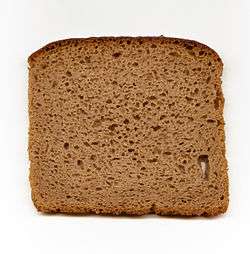Kommissbrot
Kommissbrot, formerly Kommißbrot,[1] is a dark type of German bread, baked from rye and other flours, historically used for military provisions.[2]
 | |
| Type | Sourdough |
|---|---|
| Place of origin | Germany |
| Main ingredients | Rye and wheat flour |
Description
Kommissbrot is a dark bread made from rye and wheat flours as a sourdough. It has a firm but not hard crust, and because it is normally baked in a loaf pan, it develops a crust only on the top.[2] It is noted for its long shelf life.[3]
History
Since the 16th century, Kommiß has been used as a word for a military troop, and so Kommißbrot was used to mean the bread provided for the military, since Brot is the German word for bread, and it came to be used to denote the type of bread.[1]
The nutritional value of kommissbrot was studied by Prausnitz in 1893 and by Wenceslaus Plagge and Georg Lebbin in 1897.[4][5]
It was used as military provisions in World War I, when sawdust was sometimes added to compensate for shortages of flour,[6] and in World War II.[5][7][8] A study by M. Gerson in 1941 concluded that kommissbrot covered the daily requirements of vitamin B1.[9]
Following World War I, it became available in civilian bakeries, and the recipe was changed to produce a softer bread.[2]
In popular culture
In the 1920s, the Hanomag 2/10 PS compact car was given the nickname Kommissbrot because its shape resembled a loaf of that bread.[10][11]
In the Austrian documentary film Cooking History directed by Peter Kerekes, kommissbrot is used as an illustration of the quantity of ingredients required to provide food for a large number of soldiers.[12][13][14]
See also
References
- "Kommißbrot" (pdf). Kleines Brotlexikon. Museum der Brotkultur, Ulm. Retrieved 1 September 2011.
- "Kommissbrot". Bread. German Food Guide. 2009. Retrieved 1 September 2011.
- Lüdtke, Karl-Heinz (1999–2006). "Karl-Heinz Lüdtke autobiografy part 5". Andre de Zwart. Retrieved 1 September 2011.
- Plagge, Wenceslaus; Lebbin, Georg (1897). Untersuchungen über das Soldatenbrot: Im auftrage des Königlichen kriegsministeriums (Medizinal-abtheilung) (in German). Hirschwald. p. 234.
- "Kommissbrot". Alte Armee. Retrieved 1 September 2011.
- Ganse, Alexander (15 February 2002). "War Economies". History of the Economy. World History at KMLA. Retrieved 1 September 2011.
- Byrne, Ciaran (12 December 2010). "Life in the Afrika Corps - Rations". from Elite Forces of the Third Reich. The Deutsches Afrikakorps Online Archive. Retrieved 1 September 2011.
- "Medicine: Feeding the Reichswehr". Time Magazine. Time. 28 July 1941. Retrieved 1 September 2011.
- Gerson, M. (15 July 1941). "Feeding the German Army" (PDF). New York State Journal of Medicine. New York: New York State Journal of Medicine. 41 (13): 1471–1476. Retrieved 1 September 2011.
- Gallina, Eric. "Exhibition:Taxis of the World - Hanomag Kommissbrot". Car Design News. Archived from the original on 26 March 2012. Retrieved 1 September 2011.
- Bailey, John L. (6 April 2010). "A Love Affair (with old cars)". Northeast Journal. ASL Media. Retrieved 1 September 2011.
- Heiter, Celeste (3 August 2010). "Transcending Tragedy at Cinequest 2010 - Cooking History". Things Asian. Global Directions. Retrieved 1 September 2011.
- "Cooking History". Cooking History. Archived from the original on 10 October 2011. Retrieved 1 September 2011.
- "EFA Documentary 2009 - Prix Arte: Nominations and Jury". Press Releases. European Film Academy. 8 October 2009. Retrieved 1 September 2011.